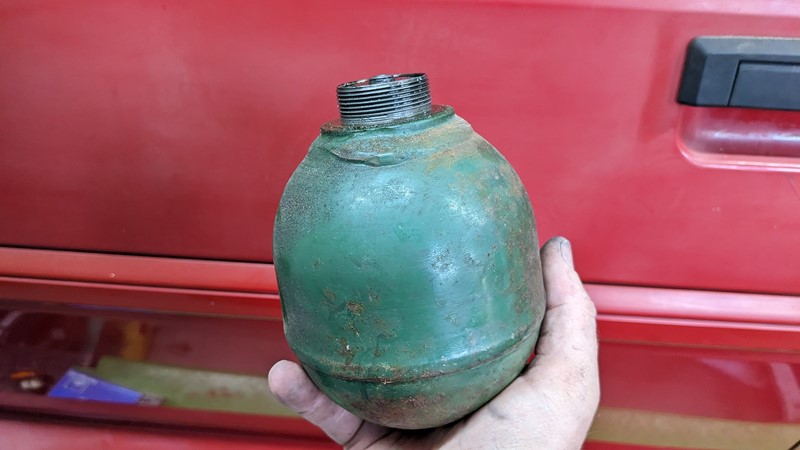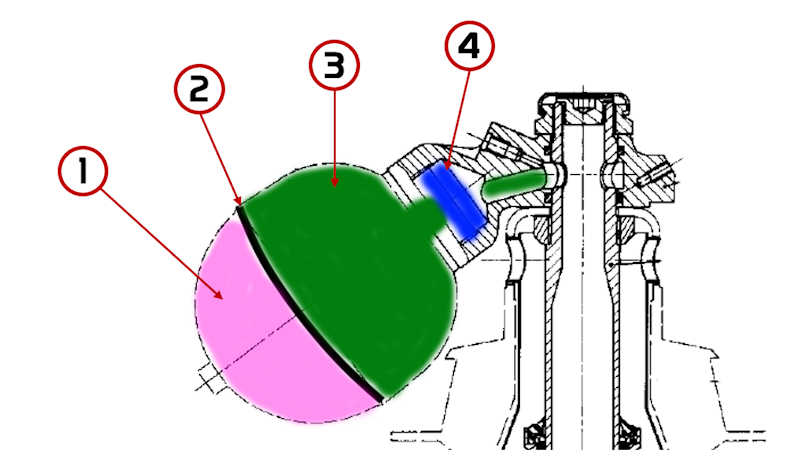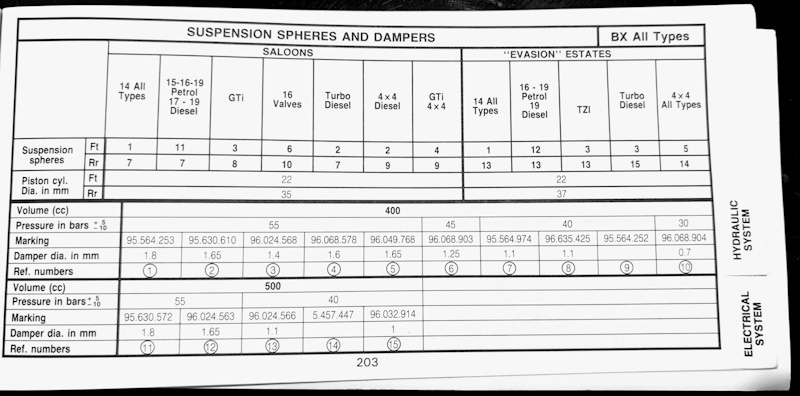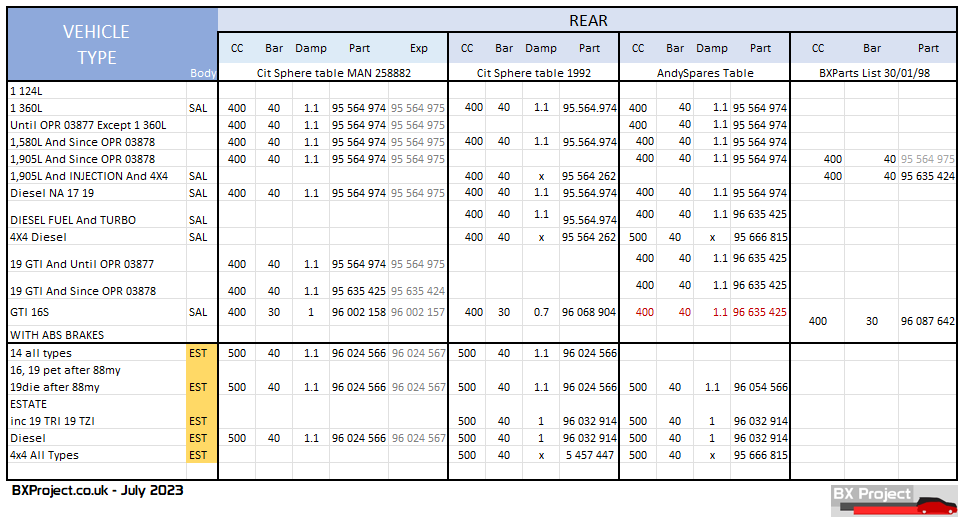For the majority of readers, what follows is probably something you already know, live and breathe. Possibly better than me! (Feel free to comment, and I’ll update anything that’s wrong). This article is for those that are potentially new to hydropneumatic Citroens or have never really considered the sphere. The purpose of the article is simply to create a reference of great sphere information that can be kept up to date and used for years to come. If it ever becomes as useful as Jon Wood’s ‘Blue Sphere Table’, I’ll be very happy. I may even try and dispel some sphere myths! So, let’s talk spheres!
Green Balls, an introduction!
The purists will tell you, “Only true Citroens have green balls”. You’ll find, as a statement, there is much to debate in the six short words. However, for the purpose of this article, the focus is very much on the Citroen BX green balls, or suspension spheres, as they are more correctly known.

This rather hefty ‘near sphere’ is the magic behind the Citroen Hydropneumatic suspension and acts as both the spring and the damper of a ‘normal’ suspension system. Personally, I’d much rather change one of these screw-on balls than wrestle with the waiting death of coil spring compressors.
What is inside the sphere?
What’s in your balls, I hear you cry, well, not much. Cast your mind back to O-level/GCSE physics lessons if you were fortunate enough to endure them, and you might remember a couple of things about liquids and gasses. One of the key differences between the two states is that gas can be compressed or squashed into a smaller space, while a liquid is already as squashed as it can be and is uncompressible. Another handy property of a gas is that the more it is compressed, the more it resists compression.

Let me start this terrible operational description by saying I’m no expert and only grasp the rudimentary principles. There are definitely better places to learn how Citroen HP suspension works. But for the purpose of this article, let’s look at some of the key elements of the suspension sphere.
1 – Chamber of Gas
Item 1 is the chamber of gas that gives the spring effect, nothing to do with Harry Potter. As the suspension fluid pushes against the gas, the gas increasingly pushes back to give a non-linear springing effect. The gas is OFN, oxygen-free nitrogen, and can be replaced when ‘lost’.
2 – Diaphragm
Item 2 is the diaphragm or barrier between the liquid and gas. I believe it is a neoprene material and about 5mm thick. It’s not the simple shape I’ve drawn here but something more like the bottom of a wine bottle. The purpose of the barrier is simply to separate the gas and liquid. The material provides no meaningful spring effect of its own. Years of flexing back and forth will eventually cause the neoprene to tear or rupture, and the gas will escape its chamber and mix with the hydraulic fluid.
3 – Suspension Fluid Chamber
This is the chamber that fills with hydraulic fluid and pushes against the neoprene diaphragm against the gas. The volume of hydraulic liquid changes either as the control valve pushes more in or when the road wheel changes relative position, i.e. over a speed bump or pothole. The higher the pressure, the more stiff the suspension becomes.
4 – Damping Plates
This is the set of damping plates. These restrict the rate at which suspension fluid can move between the suspension strut and suspension sphere. They control the reaction of the suspension to changes in the road surface, effectively damping the response for the spring. The effective damping diameter affects how responsive the system is. A large diameter makes the suspension more responsive. The car will wallow like a ship at sea. A small diameter makes the suspension less responsive, stiffer and more like a ‘normal’ car.

I will, of course, now get slated for this poor description, and that is a burden I have to bare. Any major issues will get corrected in time, but it’s handy to have a vague idea of how the system works when trying to select spheres.
Sphere Specification Breakdown
Now you have an idea of what is in the sphere, hopefully, describing the key specifications will make at least a little sense. The key values when choosing a sphere are;
- Sphere Volume
- Pressure
- Damper Diameter
Suspension Sphere Volume
For the BX, the sphere volume is either 500cc or 400cc. This is the total volume. Increasing the volume changes the ratio of gas to liquid. A higher volume will take longer to fill for the same damper diameter and thus change the spring rate.
Suspension Sphere Pressure
The pressure in bars is an indicator of the amount of gas in the gas chamber at the point of manufacture, i.e. with no hydraulic fluid in the sphere. The resting pressure of the gas sets the amount of resistance available or the strength of the spring effect. More gas is equivalent to more spring. This gas can naturally escape the diaphragm over time, so measuring the sphere pressure can give a good understanding of its health.
Suspension Sphere Damper Diameter
The damper diameter is the effective hole size through the damper plate pack at the end of the sphere. A bigger hole means suspension fluid can flow more freely, and thus the damping effect is reduced. Less damping means a greater spring effect, so the car feels less connected to the road. Words like ‘floaty’ and ‘wallowy’ are used to describe higher damper diameter. Less controlled would be an equally fitting description. On genuine spheres, the diameter is marked in lines on the bottom of the damper plate.
So why isn’t there one sphere for sporty and one for floaty response? Well, the amount of work the suspension has to do is linked to the vehicle’s weight. A BX14 is considerably lighter than a BX 4×4 estate, for example. Hence, getting the correct sphere for the right model can have a big impact on the enjoyment of the Citroen BX ride.
Choosing the Correct Sphere
If sphere specifications are so complicated and have such a significant impact on ride, how do you choose the right sphere? More importantly, where do you get them from, and are there any you should avoid?
The Blue Sphere table.
Many decades ago, a young chap by the name of Jon Wood created something miraculous. It was at a point where Citroen where either depleted of sphere stock or insanely priced. I’m not sure if it was in the era of the long lost ‘Andy Spares’ or shortly after the formation of ‘German Sweedish and French‘ the miracle happened. What Jon created was the table below (well, a longer version of this excerpt). The table is a very quick lookup of what sphere goes where based on the sphere spec from the Andy Spares supplier back catalogue. And for so long, it was very much the go-to reference for choosing spheres.

A lot of time has passed since the Blue Sphere Table was first published, probably twenty years or more. It’s not 100% accurate to the Citroen specs, as not all sphere volume, pressure, and damper sizes were available. But I’ve ordered many sets of spheres from GSF, directly by part number, based on the accuracy of the table. Unfortunately, Andy Spares is long gone, and GSF has become a massive corporation which no longer stocks spheres.
The Official Citroen BX Sphere table
Section 9 of the Citroen workshop manual for the Mk2 BX (MAN 258882) contains the table below. I consider this to be the absolute definitive list of suspension spheres.

However, the English language workshop manual, as excellent as it is, was released in the late 80’s, probably in 1989. Things change, as the Technical Bulletins will attest to. The latest Citroen publication of sphere specs that I have is from CAR 050920. The ‘Private Cars’ handbook is a quick reference of key vehicle specifications that Citroen re-issued year after year, and the 1992 edition is the last I can find referencing the Citroen BX.

And predictably, the 1992 Citroen official document (shown above) is different to the workshop manual and the Andyspares catalogue and the current online Citroen parts catalogue.
The BXProject Sphere Table
Along with the Andyspares table, Citroen workshop manual and CAR handbook, I have taken some time to cross-reference against the Citroen parts catalogue at catcar.info. And the more I dig, the more confused the answer to ‘what is the correct sphere for my car’ becomes harder to determine. So the best I can offer is to provide the data I have found, and you can make your own decision!


Coupled with the broad range of reference lists is the reality of availability. Many of the sphere spec combinations are simply not available to buy. While the damper diameter is probably the most important factor in sphere selection for the BX16Valve, I don’t remember ever seeing a sphere with a 1.25 damper. Ultimately, you’ll be stuck with what you can actually buy, but where should you buy your spheres from?
Where to buy Citroen BX spheres (and where not to!)
Historically, the best spheres were always supplied by Citroen. Genuine parts always seem to last longer and, from limited experience, seem happier to be re-gassed. Unfortunately, Citroen Parts departments haven’t had a stock of BX spheres for many years. More than ten years ago, I was informed by Citroen Coventry that they were no longer available.
So we’re stuck with buying after-market parts, remanufactured or new old stock where it can be found. Both options have their risks.
New Old Stock (NOS) spheres
New Old Stock spheres do still exist out there, but tracking them down can be mighty complicated. There are four main ways that I will try to track down any NOS parts;
- Online Marketplaces
- Citroen club meets and rallys
- Citroen parts specialists
- Knowing the right people
NOS from Online Marketplaces
Online marketplaces like eBay and Leboncoin, as much as I dislike them, are the fastest and most accessible way to find NOS parts. Spheres, especially, can be hard to identify. Many sellers don’t know what they’ve got and simply post a picture of a green ball.

NOS from club meets and rallies.
Citroen car club meets, and rallies across Europe always have at least one trader selling NOS spheres. Generally, the sellers are people like us who’ve either over-ordered or moved model or mark. There’s a hand full of sellers that have bulk bought from dealers going out of business. And a handful who are Citroen specialists that are having a spring clean or more massive clear out of ‘just in case’ parts.
NOS from Citroen specialists
Citroen Specialists like Chevronics, Garage 80NL and BX Parts often have NOS parts. Finding the right part can be a mini miracle, and in general, don’t be afraid to contact them and ask if they have something specific. These guys are well-connected and may just know where to find the elusive part.
NOS from word of mouth
Finally, one of the best ways to find the odd part is buying and knowing the right people. Years of interacting with BX owners and lovers have taught me that someone will likely have the part you need tucked away for a rainy day. Whether they are willing to part ways with prised parts is a different matter and often a personal one. The best thing is to get involved in clubs, forums and online groups. Get involved and get to know people. And if you’re lucky, when you’re in need, you’ll get a friendly tap on the shoulder.
What to remember when looking at a NOS sphere
Things to remember when looking at NOS spheres include;
- Keep an eye out for the typical Citroen packaging.
- If the part number isn’t listed, ask. The details are on the box and on top of the sphere.
- Only genuine spheres have the chevron logo stamped into the top.
- Some boxes may have a date stamp (month/year). Older is not better
- Don’t accidentally buy an accumulator instead of a suspension sphere.
- Who would be so stupid 😀
Refurbished and regassed spheres
There aren’t too many options for refurbished spheres. Unsurprising given the relative complication and small precision machined parts in the valve. As a rule of thumb, any sphere claiming to be ‘remanufactured’ or ‘refurbished’ should be avoided at all costs. This phrasing usually means the sphere has had a lick of paint and nothing more.

However, regassed spheres are a little different. Across the world are people with the capacity to pressure test and refill Citroen spheres. Many of these small companies use the ‘Technosir’ equipment to replace the gar chamber plug with a one-way valve allowing the nitrogen pressure to be topped up. This process doesn’t guarantee the sphere isn’t on its last legs, so make sure to use someone with at least a few months’ warranty. Westroen in Manchester has been offering recharge services for a few decades now.
Aftermarket spheres
Despite the age of some of the cars, a hand full of companies in the world still make the green Citroen sphere from new. While some, like IFHS, have been around for decades, other brands, like FEBI, have recently appeared. Unfortunately, not all spheres are created equal. I do wish I knew who the original supplier was.
IFHS – Generally my go-to brand. Readily available, selling large volumes, the biggest range of specifications and seem to last reasonably well. Unlikely to have been sat on a shelf for a long time if you get them from a reputable supplier.
AMTEX – Used to be the Andy Spares/GSF supplied brand, and I’ve used many of their spheres. They seem to have disappeared from the market, so I wonder if they have been bought out.
BOLK – Generally sold by Mr Auto in Europe, which is owned by PSA. I have no experience personally or anecdotally.
MONROE – Been around a little while, at least. Never heard of anyone using them, but they do appear on eBay with fair regularity.
FEBI/BILSTEIN – FEBI branded everything has arrived for the BX recently following a spate of FEBI buyouts. Probably reboxed spheres from someone else, too new to the market to have left an impression.
LIZARTE – Well-documented issues with quality, although they have been trading for a long time. Spheres from Lizarte seem to either fail within a few months (if not dead on arrival) or last for three-plus years. There is a reason why they’re at least 10% cheaper than everyone else. Personally, I avoid this brand.
Myths and Legends
Like so many things Citroen, there are many myths and legends surrounding the Green Sphere. Usually, the origins come from garages that are ill-equipped to deal with hydropneumatic Citroens to spout something out to get away from a job they don’t want. Some myths come from what I can only imagine is pub banter from German car-owning folk. And there are a few myths that have occurred due to poor publications and documentation. At the risk of infuriating Ethel of Southhampton, let’s try and tackle some of the myths.
Myth or True – ABS cars must have ABS spheres
MYTH – Kind of
Right off the bat, there is no such thing as an ABS sphere. How could there be? The ABS works on the brakes, and at least for the front suspension, there is no link. No, there is no such thing as an ABS sphere.
There are, however, some cars that are meant to have a firmer sphere when equipped with ABS. The official sphere table above does show that certain 1.9 petrol models should have firmer spheres when equipped with ABS.

The origin of the myth seems to be a catalogue from 2010 published by sphere supplier IFHS. Sure enough, there is an extra line at the bottom of each list referencing ABS. And a picture of an XM under the BX area. Despite having seen this catalogue a great many times, it was only a member of the BXClub UK Facebook group that pointed it out that I realised where the myth probably came from. Personally, I would go by the Citroen table and get as close to the right sphere specification as possible.
Myth or True – The bomb squad loves to blow up a Citroen sphere.
TRUE!
Despite the absurdity to those of us in the know, the humble green sphere has often been mistaken as an unexploded ordinance requiring the attendance of the bomb squad. The BBC article below is the only evidence still online, but I’ve seen many other articles, including one from my home town.

I think it’s generally well understood that the Citroen suspension sphere gets miss identified as hand grenades, and I completely see why. However, the statement was that the bomb squad loved blowing them up. Well, I consider that true from a couple of different engagements with the bomb squad.
The first, probably around 2008, confirmed that ‘they blow up all kinds of car parts like Citroen balls’ or something like that. They were a great group of guys who clearly enjoyed their job too much, given the risks involved.
A more recent interaction was while working at an event. I got chatting with an older gent, ex-bomb squad, who explained they used to have Citroen spheres in training just to confuse trainees. That said, sometimes actual hand grenades do get mixed in with Citroen parts as Chevronics found out in May 2021.
I’m stretching the TRUE / MYTH thing, but I’m running with it!
With the article running over 3000 words already, I’ll leave the Myth-busting for now. There are many more to tackle, though. The comedy of tractors running Citroen suspension spheres. The mythical Bentley running SM suspension and the infamous case of the E-class Mercedes. If you know any other good myths, let me know!
Wrapping up on the BX Sphere
While I hadn’t intended to write an article the length of a book, I hope this helps to guide you to good decisions when it comes to selecting and buying suspension spheres for your Citroen BX. There will no doubt be corrections and improvements to the article in the future, and I hope it can be a useful reference to all BX owners.
At some point, I need to show you how I test older spheres for the correct pressure. There will be a follow-up on the topic of spheres in the XPO series. But for now, I hope you enjoyed the read. Thanks for sticking with it, and feel free to send corrections.
M

I’ve worked on Citroen for 40 odd years. At dealers from just after the BX was introduced and for myself since 1992. The early BX spheres seemed to last for years. The introduction of the series two was around when we started replacing suspension spheres almost as a service item.
The sphere problem is a very big problem. Most replacement spares are either U/S from new or fail within months. I think the best solution is to equip oneself with the tools to recharge and buy a stock of cheap spheres.
According to a Citroen course I attended in 1989, a poor French mechanic lost his life unscrewing a GSA suspension sphere with the suspension still at full pressure. Treat them with respect.
A potential fuel thief in Colne Lancashire had to get passers by phone emergency services. He cut a rear suspension pipe. The car sank, trapping him. He was fine. True story.
Pingback: Citroën BX - Sphere Tester - BX Project